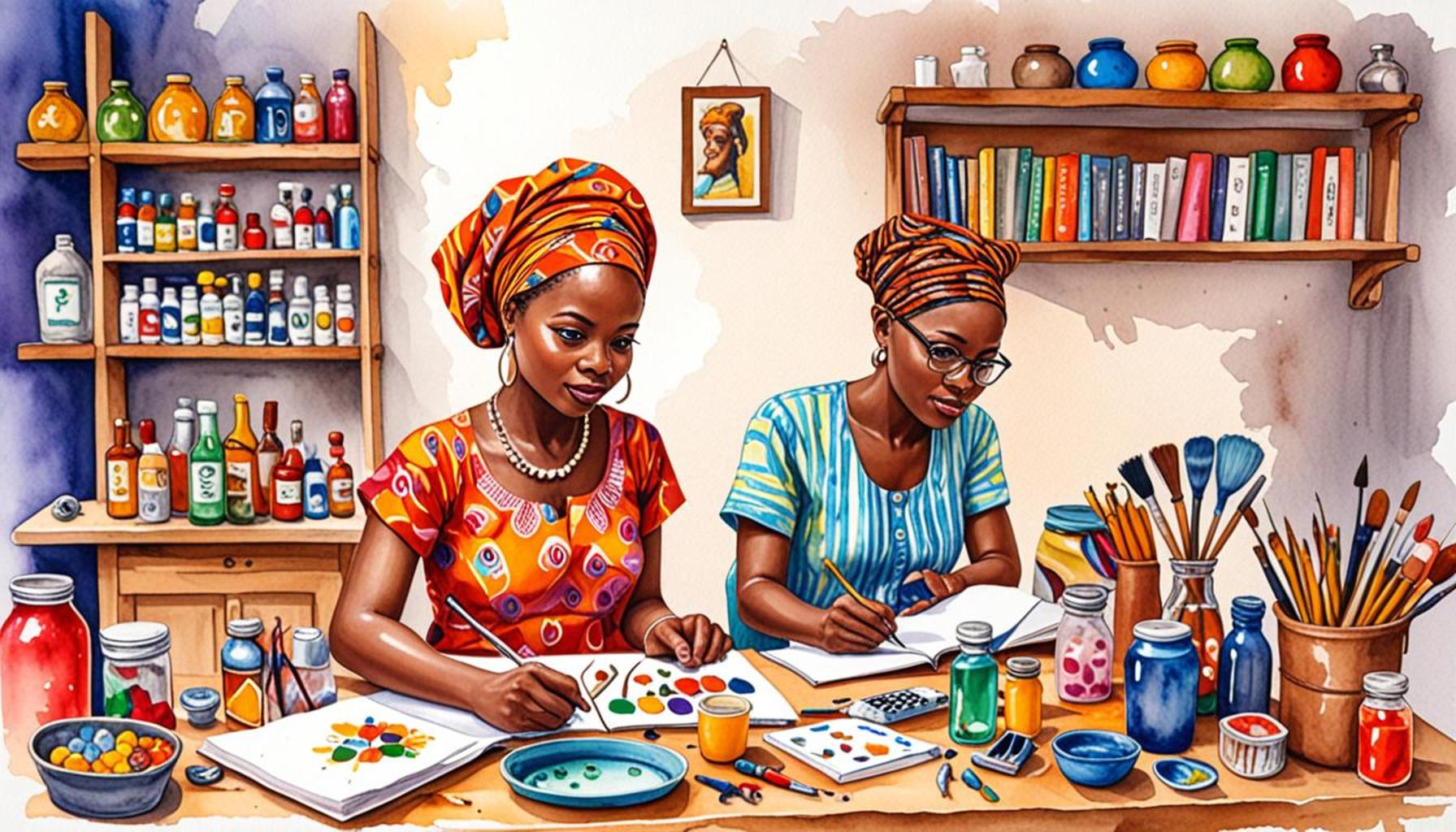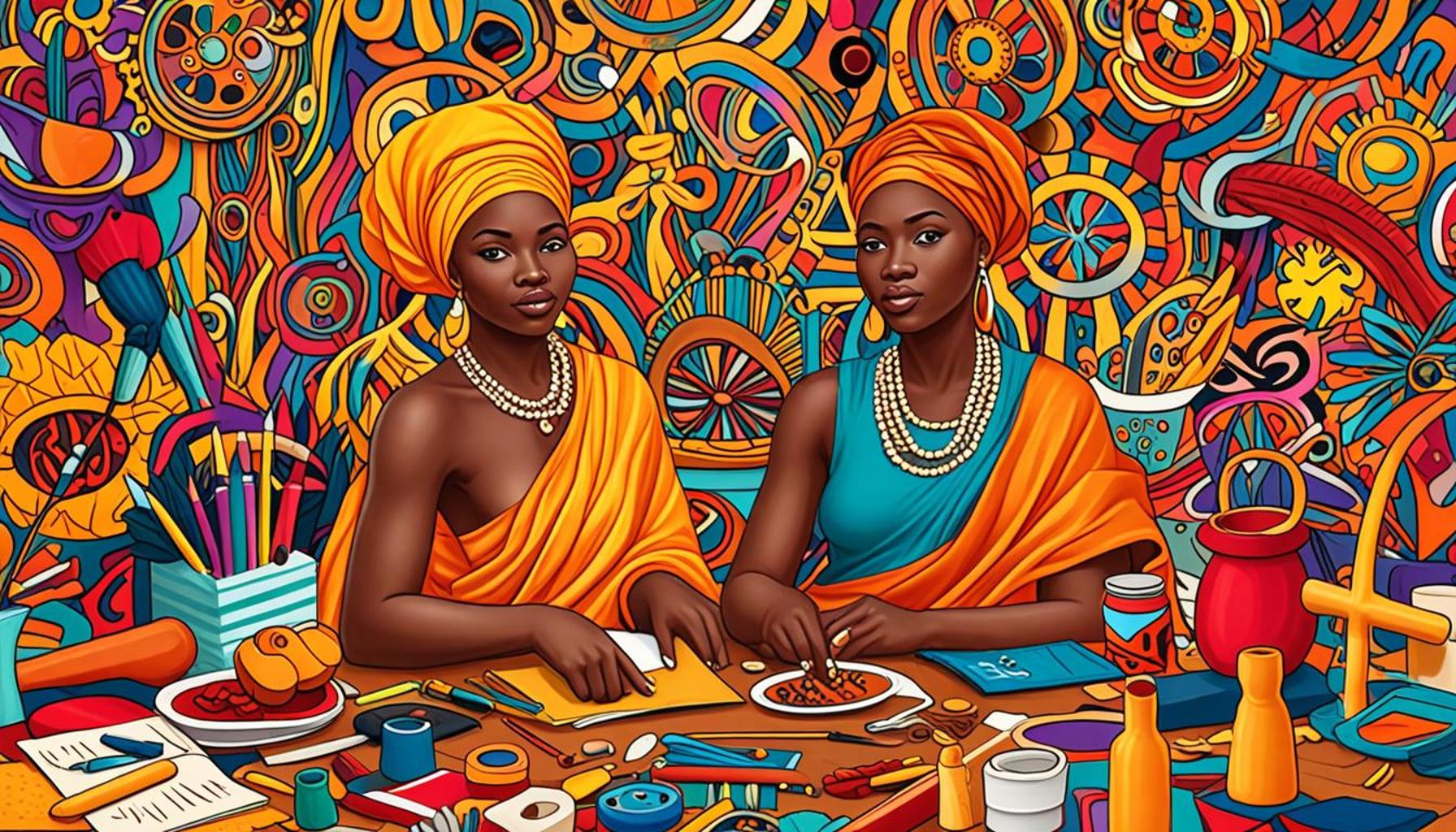Creative Entrepreneurship: How Innovation in Handicrafts Can Drive Local Businesses in Nigeria

The Vibrant Dynamics of Nigerian Handicrafts
The world of handicrafts in Nigeria serves as a testament to the country’s rich cultural heritage, embodying stories and traditions passed down through generations. This vibrant sector is not merely an artistic expression but a significant engine for local business growth. As the concept of *creative entrepreneurship* gains momentum, artisans across the nation are blending traditional techniques with innovative practices, aligning their crafts with contemporary market trends. This fusion is not only essential for revitalizing local economies but also crucial for fostering a sense of community and pride among artisans.
Innovation in handicrafts brings with it a multitude of benefits that extend beyond artistic expression. Some key advantages include:
- Job Creation: As demand for unique crafts grows, local artisans can create jobs not only for themselves but also for others in their communities. Markets such as the Lekki Arts and Crafts Market in Lagos are bustling hubs of employment, showcasing a myriad of products from woven baskets to intricate beadwork.
- Economic Sustainability: Handicrafts are often produced using locally sourced materials, which contributes to sustainable economic practices. Unique products such as Adire textiles from the Yoruba people or handcrafted pottery from the Nsukka region provide significant income for artisans, thus aiding community development.
- Cultural Preservation: By promoting indigenous crafts, artisans help to preserve their cultural heritage while simultaneously generating income. For example, traditional masquerade masks and sculptures reflect the unique narratives of Nigerian ethnic groups, creating a market for authentic cultural artifacts.
As artisans refine their skills and embrace technological advancements, they are well-positioned to create distinctive products appealing to both local and international markets. The emergence of online platforms like Jumia or Etsy allows craftsmen from various regions—from bustling Lagos to serene Ibadan—to reach customers globally. Innovations such as sustainable materials and contemporary design adaptations further enhance the allure of Nigerian handicrafts, making them more competitive in the global market.
Diving deeper into this world of *creative entrepreneurship*, one uncovers the transformative potential that these innovations hold for local businesses and the broader economic landscape of Nigeria. A stroll through colorful marketplaces—where the aroma of spices mingles with the vibrant colors of fabrics—reveals a budding industry ripe for exploration. Each artisan’s workshop, resonating with the sounds of creativity, stands as a beacon of hope, illustrating the power of craftsmanship in driving economic and social change.
In conclusion, the narrative of Nigerian handicrafts is one of resilience and innovation. As more artisans harness the tools of modernity while staying true to their roots, the future looks promising for this dynamic sector, which not only enhances livelihoods but also celebrates the rich tapestry of Nigerian culture.

ADDITIONAL INSIGHTS: Expand your understanding here
Revitalizing Local Economies through Innovation in Handicrafts
In Nigeria, the evolution of *creative entrepreneurship* within the handicraft sector is not just a trend but a vital strategy for economic revitalization. As artisans embrace innovative techniques and materials, they are transforming their crafts into modern, marketable products that reflect both cultural heritage and contemporary aesthetics. This transformation illustrates the power of creativity in the local business landscape, unlocking opportunities for artisans while engaging broader markets.
One compelling aspect of this shift is the increasing emphasis on *sustainability* in handicraft production. Local artisans are now sourcing materials from their immediate environments, which not only supports environmental conservation but also strengthens local supply chains. For example, using natural dyes derived from local plants for *Adire* textiles reduces reliance on synthetic alternatives, catering to eco-conscious consumers both locally and globally. This commitment to sustainability enhances the value proposition of Nigerian handicrafts and makes them more attractive to a growing demographic focused on ethical consumption.
Moreover, the integration of technology in this sector cannot be overlooked. Artisans are harnessing digital platforms to showcase and sell their crafts to a global audience. Platforms like Instagram and new online marketplaces such as *KoJo* or *Buni* allow them to reach consumers far beyond geographical constraints. This not only expands their customer base but also encourages healthy competition that drives innovation. Artisans who previously relied solely on local markets can now engage with international buyers, creating a broader scope for income generation.
The effect of this shift can be felt in several ways:
- Increased Visibility: With the rise of e-commerce, handcrafted products from Nigeria are gaining exposure to international markets. Artisans can share their unique stories, which fosters an emotional connection to their products.
- Expanded Skill Sets: Collaborations with designers and technologists encourage artisans to acquire new skills. Workshops and training initiatives, supported by organizations such as the *Nigerian Export Promotion Council*, enhance their creative and business acumen.
- Community Development: When artisans thrive, entire communities benefit. Increased sales lead to better livelihoods, which can fund local initiatives, schools, and infrastructure improvements, creating a cycle of growth.
The intersection of creativity and entrepreneurship is reshaping the narrative of Nigerian handicrafts. As artisans explore innovative approaches, the once niche market for traditional crafts is evolving into a dynamic ecosystem where both culture and economic opportunity flourish. The potential for growth is immense, as this revitalization harnesses the vibrant energy of creative minds while building a sustainable future for local businesses.
In this context, government support and policies that encourage innovation and entrepreneurship play a pivotal role. By fostering an environment where creative ideas can thrive, such as through grants and incentives for small-scale artisans, Nigeria can enhance its position in the global handicraft market. With creativity at the core, the future of local businesses and the handicraft industry appears bright, rooted in the rich traditions of the past while boldly stepping into a new era of innovation.
Creative Entrepreneurship in Nigeria’s Handicraft Sector
Nigeria’s handicraft sector is teeming with potential, serving as a vital source of economic empowerment for local artisans. The integration of innovation into traditional crafts provides unique opportunities for local businesses to thrive. Innovative techniques and modern designs help artisans to differentiate their products in an increasingly competitive market.
Key Innovations Boosting Handicrafts
Artisans are adopting new materials, technology, and design philosophies. For instance, the use of eco-friendly materials not only appeals to environmentally conscious consumers but also introduces sustainability into the marketplace. Digital platforms offer artisans broader accessibility to a global audience, allowing them to showcase their craftsmanship in vibrant online markets.
Empowering Local Communities
Creative entrepreneurship based on handicrafts is inherently community-focused. It promotes collaboration among local artisans, fostering a sense of belonging and shared purpose. Workshops and training programs boost skills development, while also enhancing product quality. As communities come together, they can create standards that ensure consistency, which is essential for building trust with customers.
A Catalyst for Economic Growth
The impact of innovative handicrafts extends beyond individual artisans. The sector has the potential to drive significant economic growth in Nigeria. By creating jobs and promoting local tourism through craft fairs and exhibitions, handicrafts can become a formidable component of the Nigerian economy. As international interest grows, the need for export-ready products becomes essential, further linking local artisans to global market demands.
| Advantage | Description |
|---|---|
| Market Differentiation | Innovative designs set local businesses apart from competitors, attracting diverse consumers. |
| Economic Empowerment | Artisans gain financial independence, leading to improved living standards in local communities. |
By harnessing innovation, Nigerian artisans are reshaping the landscape of local businesses. They are not just preserving culture; they are actively contributing to sustainable economic development, inviting more participants to join the journey of creative entrepreneurship.
LEARN MORE: This related article may interest you
Empowering Artisans: The Role of Training and Collaboration
To further strengthen the landscape of *creative entrepreneurship* within Nigeria’s handicrafts sector, it is essential to prioritize capacity building among local artisans. As the demand for innovative, high-quality handicrafts continues to rise, structured training programs and collaborations become vital. These initiatives not only hone artisans’ skills but also empower them to explore unique design philosophies and unconventional techniques that elevate the traditional craftsmanship.
Organizations dedicated to the advancement of handicrafts, such as the *Arts and Culture Division of the National Council for Arts and Culture*, are pivotal in providing workshops, mentorship programs, and access to resources that enhance artisans’ development. These programs introduce artisans to cutting-edge design trends, explore aspects of product marketing, and guide them in establishing their brands. In essence, the emphasis on capacity building directly correlates with improved product quality, positioning handicrafts as viable contenders in competitive market landscapes.
Moreover, local artisans are increasingly benefiting from partnerships with *foreign designers and businesses*. Such collaborations foster a rich exchange of ideas that can result in exciting hybrid products bridging traditional methods with modern tastes. This intermingling not only fuels creativity but also helps artisans gain insights into international market trends, thus allowing them to tailor their offerings to wider audiences. For instance, the fusion of traditional *woven baskets* with contemporary usage as home décor items can attract modern customers who appreciate both functionality and cultural heritage.
One project exemplifying this connection is the *Fashion for Good initiative*, which partners designers with local artisans to create unique product lines that honor Nigerian craftsmanship while appealing to global markets. Not only does this enhance the artisans’ creative prowess, but it also significantly boosts their marketability. Through these collaborations, artisans can achieve premium pricing for their products, enhancing their livelihoods while also advocating for the rich narratives embedded in their crafts.
Additionally, the rise of *social enterprises* dedicated to supporting artisans has changed the dynamics of the handicraft industry. Companies like *Aso Oke* and *The Ethical Fashion Initiative* are not only promoting sustainable practices but also ensuring that artisans receive fair compensation for their work. These organizations provide a platform for artisans to develop their businesses while also addressing social issues such as poverty and unemployment in their communities.
Through the effective combination of training, collaboration, and fair trade practices, artisans can establish themselves as prominent players in the global market. The shift towards a more empowered artisan community brings about a ripple effect that strengthens local economies. As artisans earn fair wages, they contribute positively to their communities by supporting local markets, investing in local talent, and fostering a culture of creativity and innovation.
In essence, the growth of *creative entrepreneurship* within Nigeria’s handicraft sector holds significant promise. By investing in artisans through education, collaboration, and sustainable practices, the potential for economic transformation is immense. This holistic approach not only drives local businesses but also protects the cultural heritage of Nigeria, ensuring that the stories woven into each handcrafted product continue to thrive in an ever-evolving marketplace.
SEE ALSO: Click here to read another article
Conclusion: A Pathway to Sustainable Growth
In conclusion, the realm of creative entrepreneurship within Nigeria’s handicrafts sector stands at a pivotal juncture, ripe with potential to galvanize local economies and preserve cultural heritage. The commitment to empowering artisans through structured training and collaboration has already begun to reshape the industry, offering a blueprint for sustainable growth. By effectively merging traditional craftsmanship with contemporary design, artisans are not only enhancing their product offerings but also increasing their visibility in a crowded marketplace.
The symbiotic relationships formed between local artisans and international designers illuminate the vast opportunities for innovation in handicrafts. Such partnerships result in unique products that resonate with global consumers, proving that Nigeria’s rich artistic heritage can command attention on the world stage. Social enterprises must continue to play a critical role, fostering fair trade practices that ensure artisans receive just compensation while addressing pressing social issues.
As these artisans gain rightful recognition, the positive impact extends beyond individual livelihoods; it injects vitality into local communities. With every handcrafted product sold, artisans reinvest in their neighborhoods, nurturing a culture of creativity and economic resilience. The exceptional stories behind each craft not only enrich the market narrative but also create a sense of belonging and pride among consumers.
Ultimately, the advancement of creative entrepreneurship in Nigeria’s handicraft industry is not merely a trend but a transformative movement. It offers a compelling argument for all stakeholders to rally together—government, businesses, and the communities— to cultivate an ecosystem where creativity thrives, ensuring that the legacies of Nigeria’s artisans continue to flourish for generations to come. Only through sustained effort and innovation can we fully realize the immense promise that lies within this vibrant sector.


